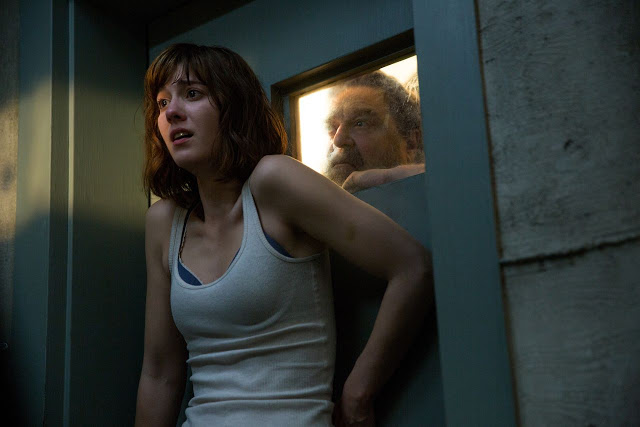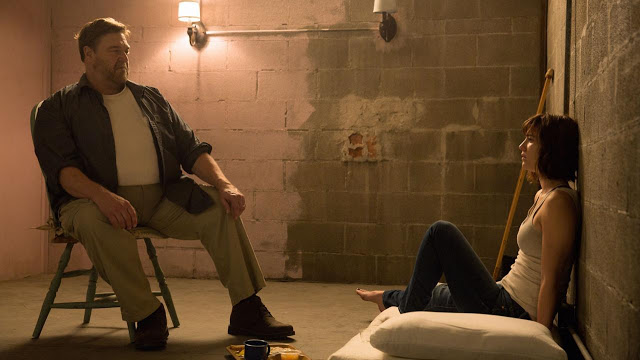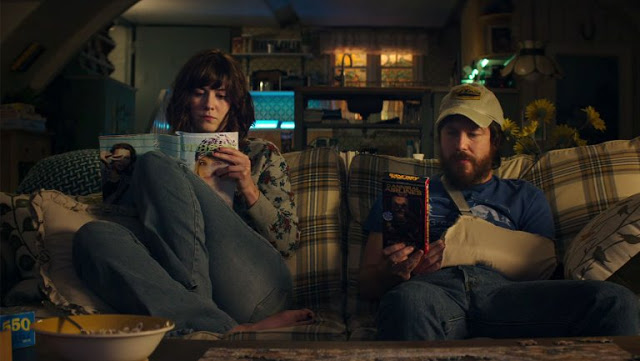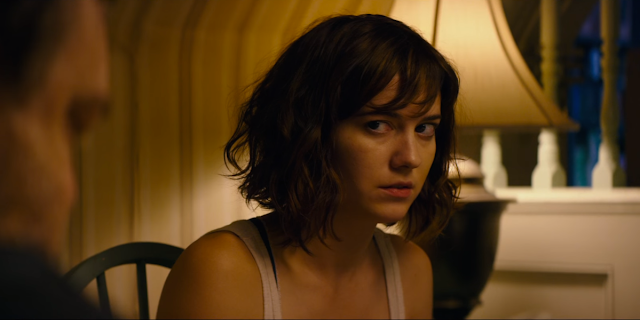Michelle is a runner. When trouble approaches, she takes off. This tendency toward flight makes her the perfect sufferer in 10 Cloverfield Lane, a tense, riveting thriller that filters hoary science-fiction and horror tropes through the lens of claustrophobic terror. It’s a lean and efficient film that takes place entirely in a single location, one that Michelle spends most of her time desperately trying to escape. Oh, and it might also be about the apocalypse; then again, maybe not. To Michelle, it hardly matters. When you’re trapped in an underground bunker, who cares about the rest of the world?
10 Cloverfield Lane opens with a brisk, eerie prologue, a near-silent montage that finds Michelle—you guessed it—on the run. She’s fleeing New Orleans after fighting with her fiancé—surely those reports on her car radio about rolling blackouts can’t be important—and though she receives a conciliatory phone call from him (his voice belongs to Bradley Cooper), she isn’t inclined to turn around. Instead, she keeps driving on a deserted two-lane road until WHAM! she’s the victim of a sudden car crash. And I do mean sudden. The collision, which director Dan Trachtenberg brilliantly intercuts with the film’s silent opening titles, is a heart-stopping moment, the kind that frays your nerves and rattles your bones. It is not the last time this sharp, merciless movie will provide a shock to your system.
But while 10 Cloverfield Lane may be uncompromising, it is not unfair. That is, it does not pummel you with spectacle or assault you with incident. It is instead a sinewy, expertly calibrated chiller, one that builds and breathes rather than stomps and shouts. When Michelle (Mary Elizabeth Winstead, excellent) wakes up, she finds herself in a small, windowless cellar, with an IV jabbed into her arm and her leg cuffed to the wall. At this point, the movie feels less like the self-proclaimed “spiritual sequel” to Cloverfield—the J.J. Abrams-produced surprise smash from 2008 that married monster-movie hijinks to found-footage horror—than a remake of Room. Michelle’s immediate reaction is to want to escape her apparent prison, an instinct that only intensifies once Howard shows up, a tray of food in his hands and a gun strapped to his hip.
Howard is a burly, unsmiling fellow played with exquisite subtlety by John Goodman. He cuts a threatening figure, but where Michelle perceives Howard as her captor, he insists that he’s in fact her savior. America, he says, has fallen victim to a horrible attack—”maybe Russians, maybe Martians”—and he has graciously transported Michelle to his bunker, which shields them from the toxic fumes that are currently smoldering above the surface. Thankfully, Howard is quite the survivalist, and his bunker is fully stocked with food, running water, an air circulatory system, and a generator. (Conveniently, he appears to have neglected stocking up on gas masks.) All they need to do is remain in this tiny dungeon until it’s safe to return above ground in, say, a year. Maybe two.
This delicious setup establishes 10 Cloverfield Lane as a fascinating study in information asymmetry, for both characters and audience. Michelle is initially convinced that, whether Howard is lying or just plain nuts, she needs to get the hell away from him. But as the movie progresses, she gradually realizes just how little she (and, by extension, we) actually knows. Howard is clearly an odd duck—his social mannerisms are awkward, particularly when he tries to be friendly—but Michelle is never sure whether he is a predator, a lunatic, or a prophet. She must also grapple with the suspicious presence of Emmett (John Gallagher Jr.), the third member of this confined crowd. Emmett is in many ways Howard’s opposite: a young, folksy charmer who seems to be as carefree and pleasant as Howard is rigorous and stony. But he nevertheless corroborates Howard’s claims, professing to Michelle that he witnessed the attack before scrambling to the bunker just in time.
Is Howard telling the truth? Is he a maniac? Could it be both? The beauty of 10 Cloverfield Lane lies in its patience in answering these questions, and in placing you firmly in Michelle’s headspace. Apart from a few throwaway scenes, virtually the entire movie unfolds from her perspective, and that narrow point of view is critical to establishing the film’s claustrophobic, panicky tone. The script—doctored by Whiplash‘s Damien Chazelle from an original (i.e., pre-Cloverfield) story by Josh Campbell and Matthew Stuecken—features its share of startling reveals, but it parcels them out organically, resulting in the rare thriller that surprises but never cheats.
Yet the real triumph of 10 Cloverfield Lane is how it invests every frame with a creeping, escalating sense of menace. Certainly, our characters find themselves in a peculiar situation, one heightened with intrigue and suspense. But they also at times act like three people playing house: cooking dinner, playing board games, disposing of trash. (Howard’s bunker really is state-of-the-art.) In a sense, the film follows a meticulous pattern, alternating between high-octane set pieces and more prosaic stretches of seeming banality, with regularly scheduled plot twists thrown in to goose the tension. Those set pieces are classic white-knuckle stuff; a scene where Michelle wriggles through the world’s tiniest air duct will have you covering your eyes, while a single, shocking gunshot literally dropped my jaw. But even the periods of relative inactivity coil with dread. A simple game of Taboo transforms into a harrowing moment of fear. The stitching of a wound trembles with uncertainty. A polite request for a condiment doubles as a diabolical strategic maneuver. A loose screw in a vent tumbles to the ground, and a subterfuge is exposed.
This is all masterfully done, but what’s most notable is the restraint. Operating with such a small cast and in a single space, Trachtenberg (making his first feature) resists the temptation to inflate the proceedings with artificial flourishes. He instead relies on unfussy camerawork—blessedly, this quasi-sequel abandons the first film’s found-footage format—and lets his actors tell the story. Performances are crucial in a film such as this—if you don’t accept the characters’ terror (and their terrorizing), the whole enterprise crumbles—and the cast embraces the challenge. Gallagher Jr. does fine, understated work as Emmett, while Goodman brilliantly burrows inward; Howard is scary not because he’s sinister but because he’s erratic, and Goodman emphasizes the character’s paranoia and wild unpredictability. But it is Winstead who carries the movie, imperceptibly articulating Michelle’s constant mental cartwheeling. Her mind is always racing, and it is exhilarating to watch her attempt to extricate herself from this very sticky wicket.
It is only in its final stretches where 10 Cloverfield Lane falters, bumping up against the limitations of its conceit. In cinema, it is far easier to ask tantalizing questions than to provide satisfying answers. Eventually, we must learn what’s really going on, at which point the film morphs from a fraught triangular power struggle into, well, a sequel to Cloverfield, complete with hokey B-movie homages and resourceful derring-do. This conclusion, while enjoyable and visually auspicious, is hectic and ultimately mundane, the inevitable letdown that can’t capitalize on the juicy setup.
But the disappointing familiarity of the movie’s finale cannot obscure its impressive verve and agonizing tension. Here is a film that dumps three people in a tinderbox, then lights a match and waits for things to explode. That may sound sadistic, but there is too much craft and intelligence on display here for unpleasantness to fester. As soon as she wakes up in that bunker, Michelle just wants to get out, but I’ll actually take Howard’s side. With a movie as gripping and well-executed as 10 Cloverfield Lane, I’m all in.
Jeremy Beck is the editor-in-chief of MovieManifesto. He watches more movies and television than he probably should.




